Oral
Neurofluids: Techniques & Applications
ISMRM & ISMRT Annual Meeting & Exhibition • 10-15 May 2025 • Honolulu, Hawai'i

| 08:15 |
Introduction
Kevin Chan
|
|
| 08:27 |
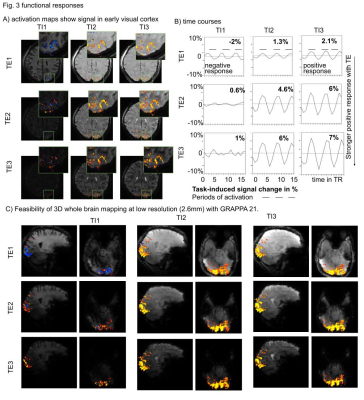 |
0018. Towards
mapping CSF volume change at high resolutions at 7T
S. Swegle, R. Huber, R. Stirnberg, P. Molfese, L. Li, C.
Walsh, A. T. Morgan, P. Bandettini
NIH, Bethesda, United States
Impact: We present a method to capture dynamic CSF
volume changes independent of CBV and BOLD during different
states of neural activity and drowsiness. This could aid
research on CSF’s role in waste removal from the brain in
diseases like Alzheimer’s.
|
| 08:39 |
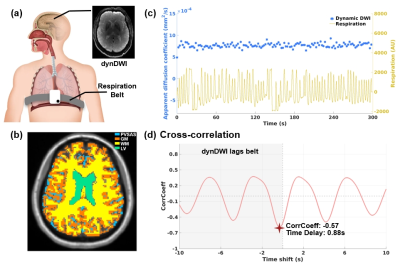 |
0019. Respiration
is a driver for parenchyma hydrodynamics: insights from dynamic
DWI

J. Zhang, E. Foster, X. Zhou, Q. Wen
Indiana University Indianapolis, Indianapolis, United States
Impact: This study highlights robust, respiration-driven
hydrodynamics in the parenchyma, with inhalation slowing and
exhalation accelerating fluid motion.
|
| 08:51 |
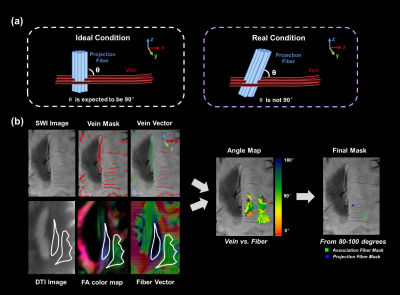 |
0020. DTI-ALPS-Plus:
A New Technique for Measuring Glymphatic System Outflow with
Enhanced Sensitivity to ISF and Robustness

B. Jiao, H. Ge, X. Zhang, Z. Wang, B. Lin, B. Sui, E.
Özarslan, R. Bai
Key Laboratory of Biomedical Engineering of Education Ministry, College of Biomedical Engineering and Instrument Science, Zhejiang University, Hangzhou, China
Impact: This work solves the problem of low
inter-observer and scan-rescan repeatability in DTI-ALPS by
semi-automatically selecting voxels having medullary veins
perpendicular to fiber orientation (DTI-ALPS-Plus), which
also enhances this method’s sensitivity to ISF dynamics.
|
| 09:03 |
 |
0026. Neural
activity induces repeatable subarachnoid CSF flow responses with
coherent spatial pathways: a concurrent 4D CSF flow and BOLD
fMRI study
F. Wang, T. Reese, B. Rosen, L. Wald, L. Lewis, J. Polimeni,
Z. Dong
Athinoula A. Martinos Center for Biomedical Imaging, Massachusetts General Hospital, Charlestown, United States
Impact: We demonstrate that neural-activation-related
hemodynamic responses induce significant directional
subarachnoid-CSF flow. Test-retest experiments showed that
the spatial patterns and flow pathways are reproducible
across runs and subjects. These findings suggest that brain
activity can effectively modulate subarachnoid-CSF flow.
|
| 09:15 |
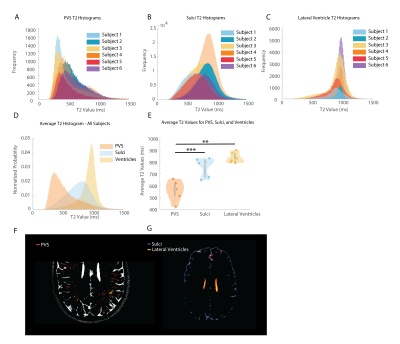 |
0021. Perivascular
CSF T2 Values compared to Sulcal and Lateral Ventricular CSF: a
window into brain clearance pathways
N. Fultz, E. Roefs, M. Nagtegaal, M. van Osch, L. Hirschler
Leiden University Medical Center, Leiden, Netherlands
Impact: The reduced T2 values observed in the PVS
suggest the presence of 'dirty' CSF, supporting the idea
that MR-visible PVS, primarily associated with arteries, may
serve not only as channels for fresh CSF inflow but as
mixing-sites of waste products.
|
| 09:27 |
 |
0022. Temporal
Dynamics-Driven Automatic Segmentation of Parasagittal Dural
Space and Meningeal Lymphatic Vessels in DCE-MRI Using VQ-VAE
J. Jang, J. Lee, H. Kim, W-J Moon, K. S. Choi
Seoul National University, Seoul, Korea, Republic of
Impact: Our proposed method may enable automatic
segmentation of the PSD and mLVs in cases of highly limited
spatial resolution, where manual segmentation may be
impractical.
|
| 09:39 |
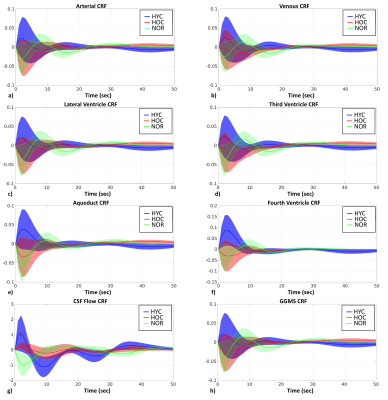 |
0023. Modulation
of neurofluid dynamics using carbon dioxide in awake humans

X. Zhong, C. Chang, J. J. Chen
University of Toronto, Toronto, Canada
Impact: We
used CO2 modulation
to highlight the involvement of slow-wave heart-rate and
respiratory variability in modulating neurofluid flow,
implicating the autonomic nervous system. This demonstrates
that it is possible to modulate neurofluid flow through
other means than sleep.
|
| 09:51 |
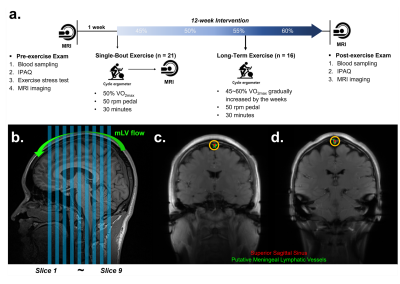 |
0024. Long-term
physical exercise facilitates putative brain waste clearance
flow in humans
J-H Kim, R-E Yoo, S-H Park, S. H. Choi
Seoul National University, Seoul, Korea, Republic of
Impact: The results demonstrate that long-term exercise
can enhance glymphatic and mLV flow, which may underlie the
neuroprotective effects of exercise. These findings could
lead to new interventions for preventing neurodegenerative
diseases by enhancing brain waste clearance mechanisms.
|
| 10:03 |
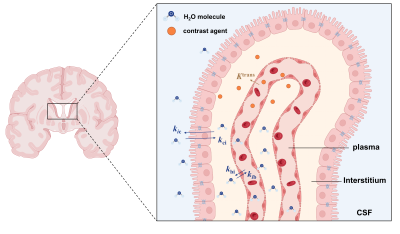 |
0025. Blood‐CSF
barrier permeability to water and contrast agent in
neurodegenerative dementias

Z. Xu, R. Li, X. Lin, C. Wen, J. Gan, Z. Chen, S. Liu,
Z. Shi, H. Wu, H. Lu, Y. Ji, H. Chen
Center for Biomedical Imaging Research, Tsinghua University, Beijing, China
Impact:
BCSFB permeability metrics derived from our novel tracer kinetic model, demonstrated significant correlations with BBB permeability and cognitive function. These findings suggest that BCSFB permeability could serve as a valuable imaging biomarker for comprehensive diagnostic metric together with BBB permeability. |
The International Society for Magnetic Resonance in Medicine is accredited by the Accreditation Council for Continuing Medical Education to provide continuing medical education for physicians.